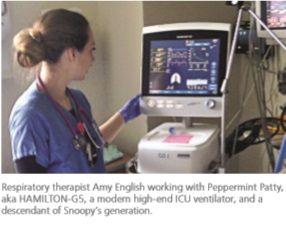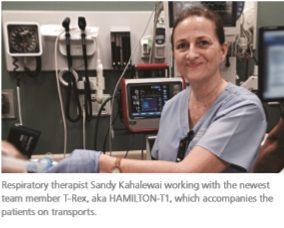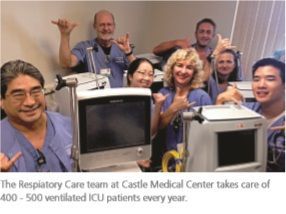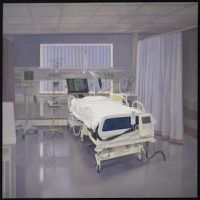Dr. Ron Sanderson with the Hamilton Medical ventilator Snoopy, aka GALILEO.
A story about the special relationship between respiratory therapists and mechanical ventilators.
Interview with Dr. Ron Sanderson, Director Respiratory Care/Neurophysiology at Castle Medical Center in Hawaii
When Snoopy left the assembly line at Hamilton Medical back in 1999, his name was GALILEO. The same name hundreds of his ventilator siblings had gotten before him. Yet, when he arrived after a long journey at the Castle Medical Center in Hawaii, he got a new name. From then on he was Snoopy, and his job was to save lives. Despite his age, Snoopy is still a valuable member of the ICU ventilator family, and has saved over 400 lives and counting.
Dr. Sanderson, the Castle Medical Center names all of its ICU ventilators. Why is that?
There are two reasons why we started to name our ventilators. We have, at any given time, 12 to 14 ventilators in our unit. If they have a name it is much easier to keep track of where they are. If I ask, for example “Where is Snoopy?”, everyone knows which ventilator I am talking about, as well as where it is. So it makes communication easier and a lot more fun. The other reason is, that by giving them a name, the ventilators stop being just a machine and become a character, an entity. We give them funny and cheerful names, mostly from comic figures that everyone has positive associations with. That cheers up our workplace a lot.

Does this affect the patients and their families too?
Yes, absolutely. The ventilators have their name clearly visible written on them for everyone to see. The families often ask about it. They smile when we tell them the reason and it makes them happy. The ventilator keeps their loved ones alive, and if they feel good about that machine, it makes their lives a little easier too.
Who gets to pick the name for new ventilators?
The idea was initiated by one of our respiratory therapists, and mostly the RTs get to name the vents. However, I do ask that the names be passed by me and the original person who started the naming to make sure they are positive, happy types of names.
Does respiratory therapy have a special role in your ICU?
I would say so. The respiratory therapists are an essential service at our hospital. The ICU considers them as part of their team and in our hospital only the RTs are allowed to manipulate the ventilators. No one else is allowed to make changes. The intensivist tells the RT which mode and what rate, and the RT does all the fine tuning. They are the ventilation experts here.

Do they like to work with the Hamilton Medical ventilators?
Back in 1998, when we introduced the new Hamilton Medical ventilators to our unit, the staff was rebelling against it. We were early adapters of the new Hamilton Medical technology with automated ventilation, and they were very skeptical. However, as soon as they tried it themselves, they liked it very much.
What made them change their minds?
The use of the automated ventilation mode ASV (Adaptive Support Ventilation) had a big part in that. We use ASV on all of our ventilated patients with very good success. The patients are comfortable sooner and the ventilator constantly adapts to their condition, so the RTs have less work and can concentrate on evaluating the patient. Also, the Hamilton Medical ventilators display more information than any other ventilator, and it is is arranged in the same way the RTs think, so that makes it very easy for the RT.
Most importantly, the Dynamic Lung image shows you the real-time condition of both resistance and compliance, visible even from the other end of the room. So the RT can see immediately when a patient is in trouble. That is very helpful, because if a patient stops breathing, it is mostly either a resistance problem or a compliance problem.

What about new RTs who come to your ICU? How do they react?
Especially for the inexperienced RTs starting in our ICU, it is great to work with the Hamilton ventilators, because they are easy to operate with and easy to understand. Thanks to their sophisticated technology, they are even able to provide the RTs with some new insights into mechanical ventilation.
So the RTs build a very special relationship with these machines, not lastly because of these funny character names. It makes it all the more easy for them to work with the ventilators, and to team up with them to save a patient’s life.
Source & Image Credit: Hamilton Medical
Latest Articles
HamiltonMedical, mechanical ventilation, Respiratory therapy
Dr. Ron Sanderson with the Hamilton Medical ventilator Snoopy, aka GALILEO. A story about the special relationship between respiratory therapists and mech...



























